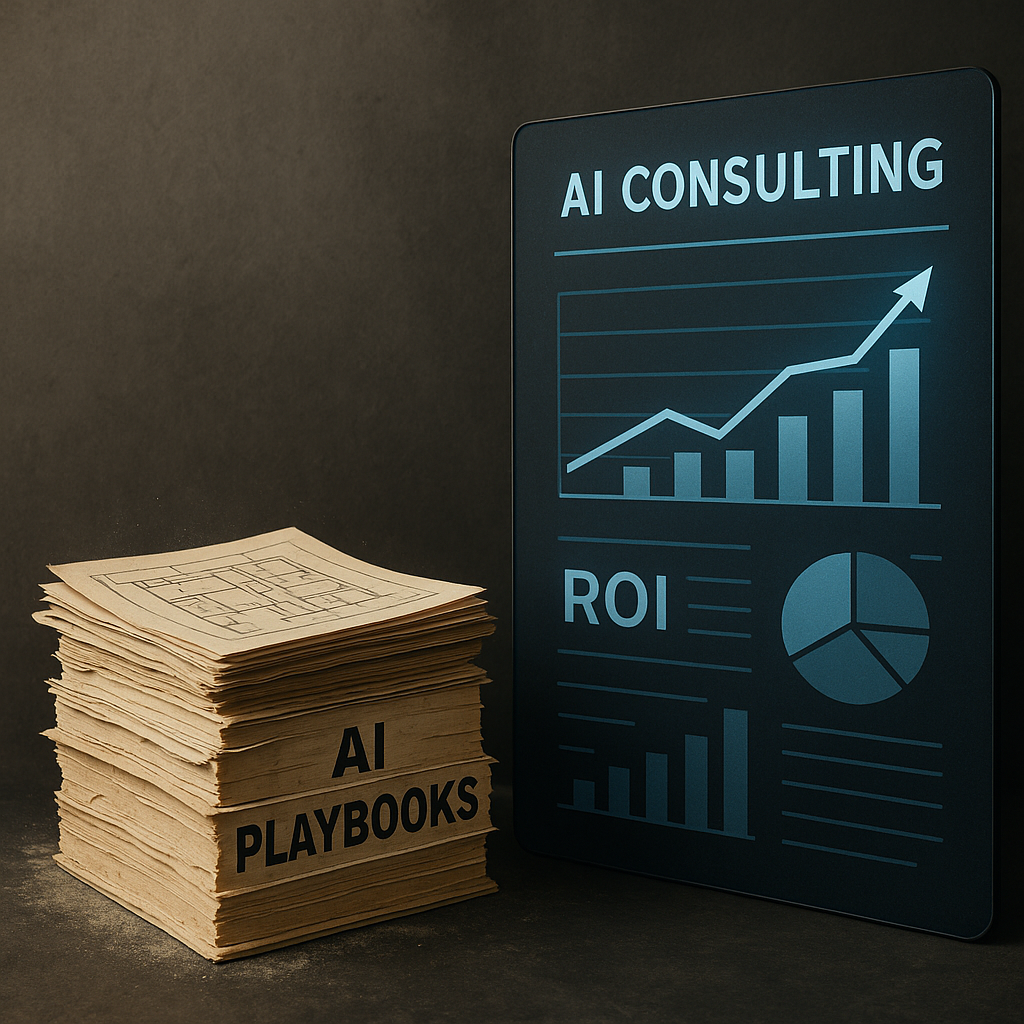Why C-level Leaders Must Pivot from Generic “AI Playbooks” to Outcome-Driven AI Business Consulting
Executive Summary
- Blueprints—frameworks, templates, viral LinkedIn “playbooks”—are everywhere. They inspire experimentation and democratise AI ideas, yet they almost never translate into hard numbers on the income statement.
- Traditional advisory services—lengthy slide decks, endless workshops, but little execution—are equally passé. Boards no longer fund “tell-but-don’t-do” engagements.
- The new bar: AI business consulting that implements, integrates and proves ROI—moving the needle on cost, growth and risk in measurable ways.
- McKinsey’s own research underscores the urgency: >80 % of companies now use GenAI, yet >80 % report zeromaterial bottom-line impact and only 1 % call their strategies “mature”.
1. The Blueprint Illusion
1.1 Why Blueprints Proliferate
- Low friction: anyone can post a “Top‑10 AI Hacks” thread.
- Perceived safety: copying a viral framework feels less risky than building from scratch.
- Democratisation: they help non‑experts understand possibilities.
Blueprints are “valuable” as inspiration—but valuation stops at that word. No CFO books inspiration as revenue.
1.2 Where Blueprints Fail the Business Test
Bottom line: blueprints spark ideas but cannot substitute for disciplined execution, governance and accountability.
2. Classic Consulting Is Out of Season
Traditional consulting’s playbook—diagnose, design, disappear—struggles in today’s compressed strategy‑to‑value cycles:
Boards now ask, “Show me the first €1 million savings in Q–1, not a 500‑page masterplan.”
- Advice without ownership leaves delivery to clients already talent‑constrained in AI.
- Slide‑deck metrics seldom survive first contact with real data.
- Marathon timelines (18‑month roadmaps) no longer fit markets where GenAI models update weekly.
Boards now ask, “Show me the first €1 million savings in Q–1, not a 500‑page masterplan.”
3. AI Business Consulting 2.0: Implement, Measure, Repeat
3.1 Non‑Negotiables of the Modern Engagement
- Implementation muscle – integrate models into live workflows, not labs.
- Measurable results – define and track KPIs from day one.
- Predictable ROI – build financial models credible enough for CFO sign‑off.
- Change management – upskill teams, redesign roles, secure adoption.
“Focusing on implementation and measurable ROI is the only viable path,” notes deep‑dive research on AI consulting.
3.2 Why It Works
- Justifies investment: Hard numbers beat hype every time.
- Aligns with strategy: Projects tie directly to growth, cost or risk objectives rather than “AI for AI’s sake”.
- De‑risks delivery: External experts close talent gaps—89 % of mid‑market firms say they need outside help to execute AI.
- Builds trust: Tangible wins turn sceptical employees into champions; KPI‑tracked AI rollouts correlate with superior P&L impact.
4. From Paradox to Pay‑Off—A Roadmap for the C‑suite
5. Case Snapshots—Blueprint vs. Implementation
6. Calculating Predictable ROI—A Quick Framework
- Baseline current cost (FTEs, error rates, inventory, churn).
- Model impact levers (automation %, accuracy gains, revenue uplift).
- Estimate run‑costs (inference, licences, support).
- Simulate best/worst cases; pressure‑test with Finance.
- Track actuals vs. model monthly; revise go/no‑go for scale.
When done rigorously, executives know whether the next AI euro delivers 3× or 0×—ending the current zero‑ROI paradox.
Conclusion: Inspiration ≠ Impact
- Blueprints matter—they seed ideas and democratise know‑how.
- But business impact demands execution. Value accrues to firms that convert AI excitement into bottom‑line gains.
- Old‑school consulting can’t keep pace. Boards expect implementation, measurable results and predictable ROI.
- Your call to action: Sunset the slide‑ware, invest in an outcome‑driven AI squad, and insist every penny spent on AI pays rent in the P&L.
The time for experimentation is over. The time for transformation is now.
